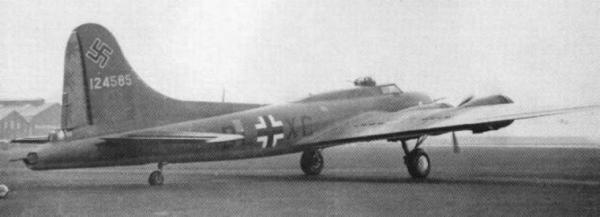
|
A Luftwaffe Test Pilot's Account of a Captured B-17 |
 |
||||||||
|---|---|---|---|---|---|---|---|---|---|---|
 |
 |
 |
 |
 |
 |
 |
 |
 |
 |
| Additional Notes: | 
A Luftwaffe Captured Boeing B-17 Flying Fortress. |
A Luftwaffe Test Pilot's Account of a Captured B-17Luftwaffe Test Pilot by Hans Werner LerchePerhaps there were other aircraft that were even more pleasant to fly than the B-17, because it did have its drawbacks: for example, the forces acting on the ailerons were relatively high, and the rudder felt as if it were set in concrete. But it was much more important that the aircraft was easy to fly and land. When one had become accustomed to the higher all-up weight and the strange instruments, it could be compared with our He 111 in the degree of effort needed to fly it. What was really outstanding about the B-17, which made it, together with the Liberator, the standard day heavy bomber in the European theater of war? It certainly was not fast in low altitudes; only the exhaust-driven turbosuperchargers gave the B-17 its good performance at higher altitudes. All in all, that was for me the most admirable thing about American planning, namely the consequential pursuit of a concept once it had been recognized as correct, in this case the effectiveness of raids, carried out by well-armed high-altitude bombers flying in close formations. Occasionally I would receive via Switzerland foreign reports on German aircraft, and it was interesting to read that they quite often not only praised the construction of the machines, but the engines as well, more often than not concluding that the Germans just did not have the necessary heat-resistant metals for even better performance. One must remember that several years would pass between planning and execution of a concept. Possibly only the idea of keeping the attacking fighters at bay with heavily armed bombers flying in close formation and firing from all 'portholes' had to be revised. This consequently happened after the raid on Schweinfurt, which due to the long distance involved, had to be carried out without fighter escort. During this raid the USAAF bombers suffered heavy losses from twin-engined Zerstorer and single-seat fighters attacking with rocket missiles, which naturally caused quite a crisis. The correct solution to this problem was soon found: elimination of the sluggish, rocket-carrying Luftwaffe 'destroyers' by escort fighters—and several versions of these, with excellent performance, were also soon available. Nor did the rather poorly adjusted control forces on the American bombers have much detrimental effect, as this was certainly not decisive during the approach at great height, and even less so after the bombers had been equipped with an excellent three-dimensional autopilot. It must be stressed that the respectable speed of the B-17 at higher altitudes was due solely to its excellent exhaust-driven turbo-superchargers. But for the production of these devices, one required not only the know-how, but also large quantities of heat-resisting materials, which we were lacking in Germany. |
Return To Aircraft Index.
©Larry Dwyer. The Aviation History On-Line Museum.
All rights reserved.
Created September 8, 1996. Updated January 21, 2023.